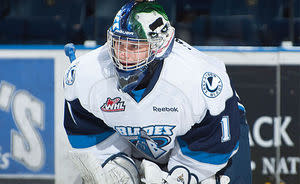GTHL to promote local development by banning foreign born-and-trained players from registration
It appears as though another provision will soon be enacted to restrict foreign hockey players from competing within – at least – a portion of Canada.
An earlier controversial rule – banning European goaltenders from the Canadian Hockey League import draft – has yet to yield desired results.
And this latest one also carries with it a cloud of uncertainty.
TSN senior correspondent Rick Westhead reported Tuesday that the Greater Toronto Hockey League is expected to pass a rule next month preventing foreign born-and-trained players from registering unless their parents set up residency in Toronto.
As Westhead explains, international families – particularly those from Russia – have been paying upwards of $30,000 to enrol their sons in private sports schools. Doing so has allowed those children to be eligible to play in the GTHL, world’s largest minor hockey system.
That loophole is bound to be closed for the 2016-17 season.
“If families are moving here for family reasons and that involves their child playing hockey, that's one thing, but we're not comfortable with children moving here just because of hockey,” GTHL chief executive Scott Oakman told Westhead.
The root of the issue, as Westhead states, is this:
Some hockey coaches and families in Toronto aren’t happy with the practice, arguing that foreign-born players take away scarce spots on teams from locally born players, hurting their development and chance to be seen by major junior or college scouts and coaches.
In a sense, this is true. The GTHL houses 38,000 players. The number of international players this season is just 37, according to Westhead. Most of those 37 players are teenagers of AAA calibre who are gunning to be picked in the OHL draft.
So those 37 players – in theory – are removing a Canadian teenager from GTHL action at or near the minor midget AAA level and limiting the chances of an OHL scout to view his skills. The rub is that the players on the outs are ones toiling on the bottom of those AAA rosters and almost assuredly aren’t good enough to make major junior or college programs anyway.
This also calls into questions, as Westhead also mentions, the CHL import goaltending ban.
Worried about the development of goaltenders in Canada, the CHL opted to prevent European goalies from entering the import draft. Starting in 2013, international goaltenders were only permitted to be selected in the first round of the draft. They were unable to be chosen at all starting in 2014.
Now, only one European goaltender remains in the CHL. Moscow native Leo Lazarev is in his second season with the Ottawa 67’s after being chosen in the second round of the 2014 OHL draft. His family had to set up residency in Ontario for that to happen.
Only 11 of the 120 goaltending jobs in the CHL belonged to imports when the rule was passed in June 2013.

However, three of the netminders – Saskatoon Blades’ Andrey Makarov (Russia), Swift Current Broncos' Eetu Laurikainen (Finland) and Red Deer Rebels' Patrik Bartosak (Czech Republic) – played in the World Junior Championship the previous season. Makarov was named top goalie of the Memorial Cup tournament. Bartosak won the CHL’s goaltender of the year award.
With the Europeans gone, the thought was that Canadians (and Americans, in this case) could reclaim some attention in the crease. It hasn’t really worked out that way. The last Canadian goalie to be selected in the first round of the NHL draft was Malcolm Subban in 2012. The last Canadian to be named top netminder at the world juniors was Steve Mason in 2008.
The jury’s still out on if banning European netminders has helped the CHL. The evidence suggests it hasn’t.
There’s nothing to suggest restricting foreign players will help the GTHL either.
If the league wants to address the quality of the action when scouts are in attendance, it might want to look at competitive imbalance.
The OHL Cup pits the provinces top 20 minor midget AAA teams against each other at the end of the season.
Since 2005, the Toronto Marlboros have appeared in every tournament.
The Toronto Junior Canadiens have appeared in all but one.
There are 10 other GTHL teams. None has appeared in more than five.
More from Yahoo Canada Sports:

 Yahoo Sports
Yahoo Sports 

